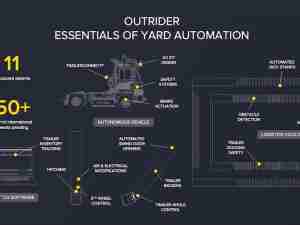| Is Your Freight Being Outsourced? | ||||
| Transportation Companies | 2015 Ranking | Annual Revenue | Purchased Transportation | Percentage of Revenue |
| JB Hunt | 3 | $6,188,000,000 | $2,994,992,000 | 48.40% |
| YRC Freight | 5 | $4,832,400,000 | $561,100,000 | 11.61% |
| Swift | 6 | $4,229,322,000 | $1,180,403,000 | 27.91% |
| Hub Group | 8 | $3,525,595,000 | $3,112,900,000 | 88.29% |
| TransForce Inc. | 9 | $2,842,937,000 | $1,868,196,000 | 65.71% |
| Landstar System | 10 | $3,321,091,000 | $2,551,343,000 | 76.82% |
| Old Dominion | 11 | $2,972,442,000 | $116,300 | <1% |
| ArcBest Corp. | 12 | $2,666,905,000 | $614,835,000 | 23.05% |
| XPO Logistics | 14 | $7,623,200,000 | $4,171,400,000 | 54.72% |
| Werner Enterprises | 16 | $2,093,529,000 | $480,624,000 | 22.96% |
| Heartland Express | 39 | $736,345,000 | $34,389,000 | 4.67% |
| Marten Transport | 48 | $664,994,000 | $118,030,000 | 17.75% |
| USA Truck | 50 | $507,934,000 | $161,370,000 | 31.77% |
| Total (weighted average) | $42,204,694,000 | $17,849,698,300 | 42.29% | |
LaneAxis Research Shows Top Carriers Outsource Nearly Half Of Freight Shipments
By: LaneAxis | May 03 2016 at 08:45 AM | Intermodal
SAN DIEGO - A LaneAxis Virtual Freight Management study of the nation’s top 50 Carriers (as ranked by Transportation Topics) revealed the 13 biggest public companies outsource an average of 42.29% of their freight shipments. This figure is based on the percentage of total revenue those carriers spent on “Purchased Transportation” – essentially subcontracted freight shipment services.
“Our findings are clear – many Shippers likely aren’t getting the visibility they think they are,” says Rick Burnett, LaneAxis CEO and Founder. “Large Shippers and Carriers may be able to manage their own fleets effectively, but with so much freight being outsourced to small Carriers with six trucks or less – which is 97% of the trucking industry – that’s a problem. There’s very little visibility into that network.”
LaneAxis researched public filings from the 13 biggest publicly held Carriers in the Transport Topics’ 2015 “Top 100” list. The research revealed those companies spent a combined $17.8 billion last year on “Purchased Transportation.” When measured against those companies’ combined revenue of $42.2 billion, that averages out to 42.29% of those carriers’ revenue being spent on freight outsourcing.
Source: 2015 Annual Reports
The research also revealed that average margin percentage for those carriers (the percent difference between Operating Income and Operating Revenue) is around 8%. So not only are customers likely losing visibility to 42% of their loads, they are likely paying 8% margin for that lost visibility.
Burnett says many Shippers turn to large Carriers, brokers, and third party logistics services (3PLs) to save on costs and hassles, but often the opposite is happening.
“We know small Carriers are the backbone of trucking – and that’s a good thing,” adds Burnett. “But many of those Carriers lack the inboard tracking units and back-office technology to deliver real-time visibility to Shippers. That often leads to lost loads, inefficiency, and confusion. Virtual Freight Management fixes that.”
Cloud-based solutions like LaneAxis Virtual Freight Management can eliminate the need for Shippers to rely on large Carriers, brokers, or 3PLs - all through a centralized platform accessible via mobile and desktop. LaneAxis VFM gives Shippers real-time visibility, data, and predictive analytics – all crucial when dealing with small Carriers. The platform also screens and monitors Carriers for compliance with insurance requirements, federal regulations, and more.
“There’s no question Virtual Freight Management is changing the trucking landscape. VFM allows Shippers to create their own ‘in-house’ network of trusted and pre-screened small Carriers. LaneAxis does all the heavy lifting in terms of compliance, connectivity, and visibility – all the way down to the driver level.”







